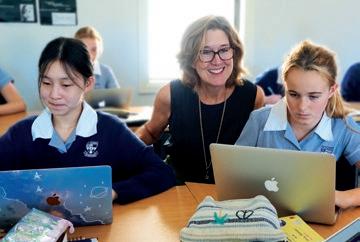
24 minute read
Ms Vanessa Furlong Alexanderson immersed herself in the French language and culture of New Caledonia, while English Teacher, Ms Sara Verge, headed to Northern Vietnam to teach English
It was interesting working with different Vietnamese English teachers and comparing their pedagogical approaches. The teacher I taught with in the primary school used a lot of games, physical activities and rote learning. In the adult and teenage classes I was often working with the Head of the Highland Centre, who was a big fan of grammar exercises and written worksheets. Sometimes the vocabulary was outdated and overly formal, so I worked with her to create more relevant dialogue for the students.
Advertisement
Visiting the orphanage
While in Hà Giang, I also spent time at the local orphanage. Most of the children there were from ethnic minorities, but not all were orphans. Some had parents who were unable to care for them. Life in the mountains can be harsh and difficult. Families here are often large and face a range of social and economic problems.
My intention was to teach the children some vocabulary, but I quickly discovered that they were not really interested in English lessons. Not that I could blame them. Sunday is their only day away from school, so they wanted to play, do craft or have stories read to them. Fortunately, I had brought along some picture books made by some of our Year 8 students at Wenona in their Design and Technology classes. They were a big hit with the children at the orphanage.
REFLECTION
My time in Hà Giang was of immense benefit to me, both professionally and personally. While studying for my Diploma in Applied Linguistics and TESOL is providing me with the academic framework behind teaching English as an Additional Language, being able to complement this pedagogical knowledge with extended hands-on experience has been invaluable. As Wenona forges closer links with schools in the Asia-Pacific region, we may expect to see increasing numbers of EAL students in our classrooms, and I am grateful for the opportunity to be better equipped to meet the needs of linguistically and culturally diverse students.
Additionally, the experience of living in Hà Giang for a month and experiencing another culture first hand was fascinating. Getting to know the Vietnamese teachers I worked with, and the students I taught, working in a Vietnamese school, being invited into students’ homes, doing craft with children in the orphanage, exploring the backstreets of Hà Giang city, travelling into the mountains and to isolated valleys where people still wear traditional dress, meeting other volunteer teachers from all over the world - all these experiences were eye-opening and invigorating.
Finally, volunteering my time and working to improve the lives of disadvantaged children and adults was personally rewarding. Speaking English is a way out of poverty for the ethnic minorities in this isolated area of Vietnam. My month in Hà Giang has deepened my understanding of the value of service and sparked a desire to do more volunteer work.
FEATURES

OVER THE PAST YEAR, EACH MEMBER OF OUR STAFF HAS CONTINUED TO LEARN, TO REFLECT, TO SEEK CHALLENGE, TO EXPLORE NEW IDEAS AND TO EMBRACE NEW WAYS OF DOING THINGS.”
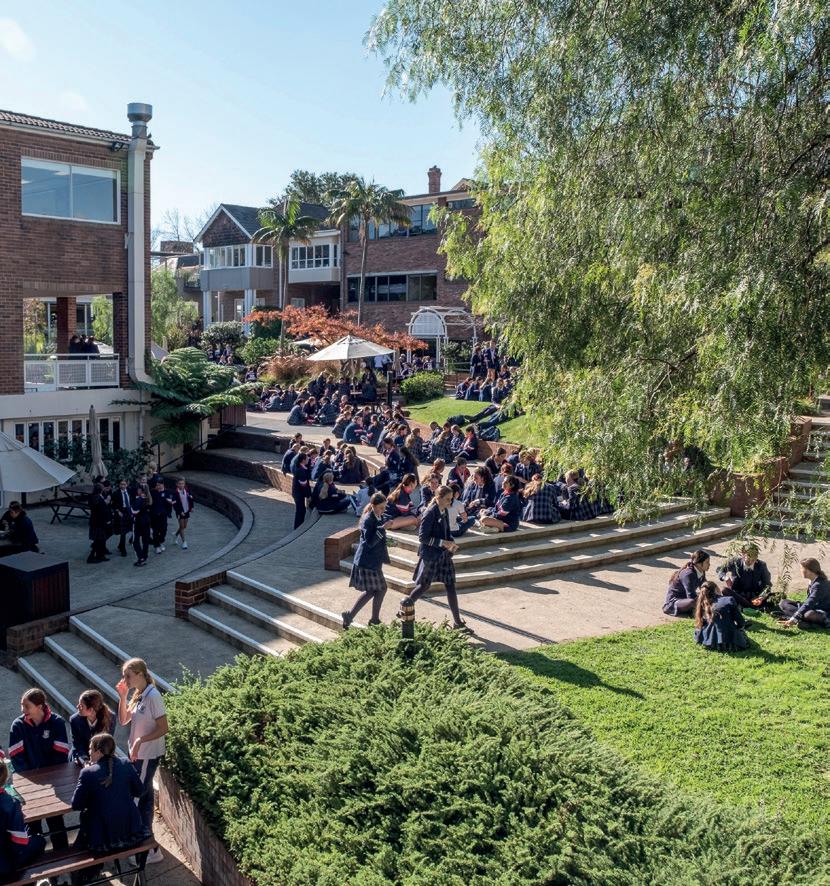
Nominated for the 2020 BHP Foundation Science and Engineering Awards - Australia’s most prestigious school science and engineering awards - Head of Science, Sandra Woodward is an inspiring scientist with a clear vision for the future of science education.

THE SCIENCE OF DISCOVERY
Inspiring the next generation of scientists
BY SANDRA WOODWARD
HEAD OF SCIENCE
Science has always fascinated me. Even as a young child, I was constantly asking questions, trying to make sense of the world around us - a world that is increasingly shaped by science and technology. As the field continues to advance, it presents us with an ever-widening pool of challenges and opportunities. Whether it’s finding new cures for cancer or identifying and exploring new galaxies, science encourages us to imagine, to create and to discover. But to come up with innovative solutions to the complex problems we face, we must always begin by asking questions. Lots of questions!
Staying curious
Early in my career, I was fortunate to have a wonderful mentor who gave me some sound advice. He told me to stay curious and to learn from everything I do because the moment we think we know it all, we stop evolving.
My passion for science has been my springboard to learning, pushing me to develop my knowledge base and broaden my perspective. Throughout the course of my career, I’ve had opportunities to learn and evolve - from a personal and scientific aspect - by collaborating with people from both industry and academia. For example, co-authoring a high school Science textbook with fellow educators taught me the value of clear communication. As Albert Einstein said: “You do not really understand something unless you can explain it to your grandmother”. Similarly, in facilitating workshops for students and staff, I’ve realised the importance of tailoring content to meet the needs and interests of a target audience.
Last year, I was awarded a scholarship to be part of The Lead & Expert Teachers Colloquium. Although this is not science-focused, it has helped to foster my leadership skills and provided me with insight into how I can better assist the development of colleagues.
Experiencing science is something that allows students to engage and develop their thinking. Handson activities, problem-solving and investigations are all important and effective means of motivating students to engage in deep learning. I was humbled to be selected as the NSW nominee to the 2020 BHP Foundation Science and Engineering Awards, which is an award that recognises work in this area.
Embracing a new syllabus
I have been teaching long enough to have been part of four syllabus changes in Science. Each iteration has tried to find a balance between helping students engage with the material and develop the skills
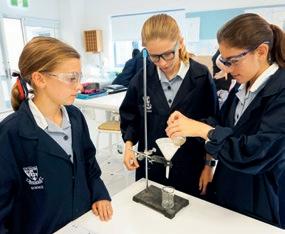
they will need beyond school. The new Science syllabus is exciting, teaching students to engage with concepts and develop skills instead of focusing solely on the memorisation of a body of facts. Yes, the syllabus is challenging, but who doesn’t love a challenge?
As a department, we have worked tirelessly to familiarise ourselves with the new syllabus. We’ve attended many different professional development activities, working with Science educators across the sector to develop the best possible programs and experiences for our students and to share best practice. And we’ve hosted workshops here at Wenona, pooling ideas, knowledge and resources with leading experts and educators to devise exciting new techniques and strategies to teach Science. In learning from each other, we are modelling what we ask our students to do, which is to work collaboratively to develop new solutions to complex problems.
Exciting new learning spaces
Science is all about discovery and Wenona’s new state-of-the-art building, the Athenaeum, which opens this year, will be an opportunity to showcase Science as it should be: inspiring, imaginative and collaborative. This exciting new space will promote greater flexibility in our teaching and learning. But it will also allow our students to work at the very edge of the unknown, applying the tools of scientific inquiry to areas they are passionate about and enabling them to develop independent research and investigation beyond the syllabus.

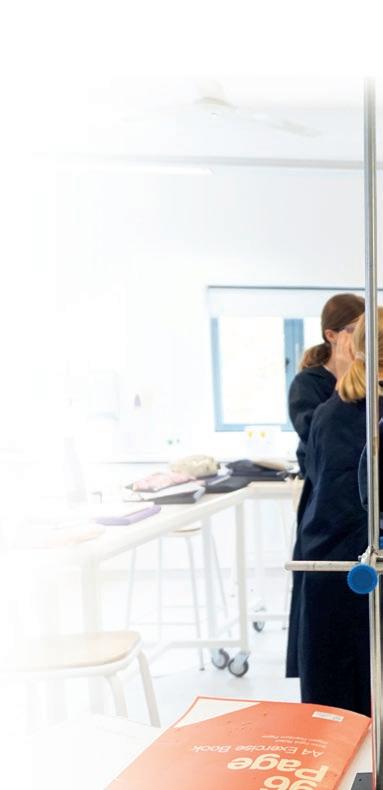
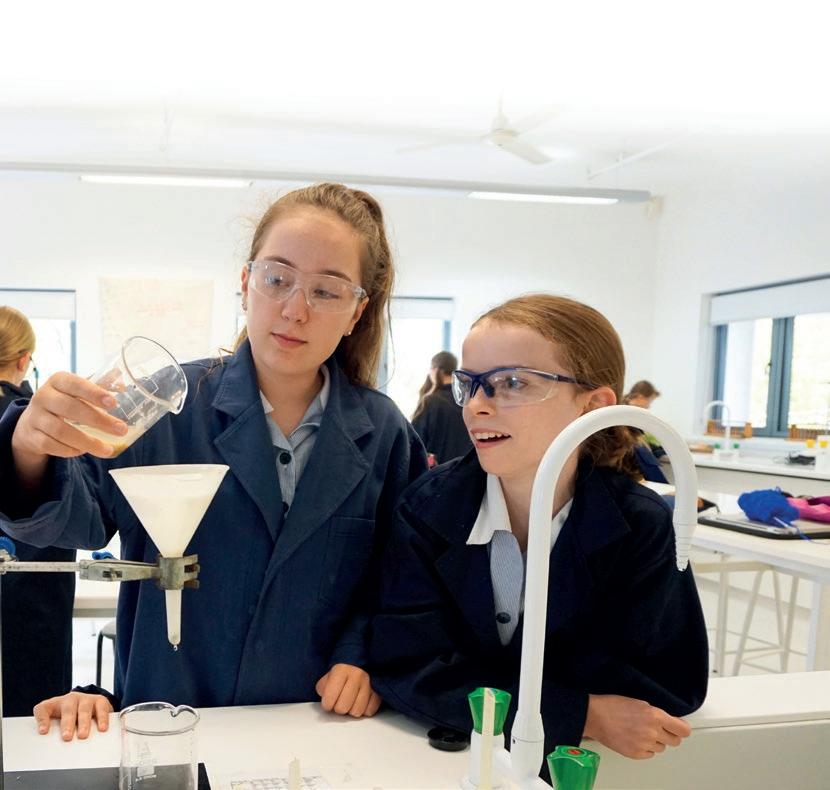
REFLECTION
In the words of American astronomer, Carl Sagan, “Science is a way of thinking much more than it is a body of knowledge.” And this is reflective of our approach to science education at Wenona. We recognise that science and technology offer part of the solution to global issues like climate change and inequality. With a new building on the horizon, and a new syllabus and new teaching strategies and techniques to inspire us, we are looking forward to planting the seeds of discovery for our future scientists, and preparing them to do amazing things for society and the world.
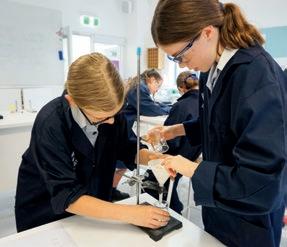
AN INTERNATIONAL EDUCATION
Communicating across cultures
BY GREG MIKKELSEN
INTERNATIONAL DEVELOPMENT COORDINATOR
Pioneering takes courage, curiosity and a spirit of adventure. On Boxing Day 1969 - long before overseas excursions were commonplace for Australian schools - the then Principal of Wenona, Miss Barbara Jackson led 18 students on a study tour of South East Asia.
As Henry Miller famously once said, “One’s destination is never a place, but rather a new way of looking at things.” For this intrepid group of schoolgirls, the opportunity to immerse themselves in the history, culture and communities of the region was a magical way to learn more about themselves and the world they lived in.
The group blazed a trail across Singapore, Malaysia, Thailand and Cambodia, travelling through dazzling rice paddies and swaying sugar palms to explore the fabled ancient temples of Angkor. They touched down briefly in Vietnam – where a cluster of US war planes on the airstrip was the only visible sign that the country was at the height of the Second Indochina War - before heading off to the bright lights of Hong Kong. Their journey ended in the Philippines, where they took a trip in dugout canoes, travelling through dramatic gorges hemmed in by towering cliffs, to see the spectacular Pagsanjan Falls - a decade before they were made famous in the final scenes of Francis Ford Coppola’s epic war movie, Apocalypse Now.
A global learning community
More than 50 years have gone by since that first overseas school tour and in that time, thousands of Wenonians have crisscrossed the globe to engage with the world in all its diversity. With a Principal who has run the Great Wall of China and walked all 96 kilometres of the Kokoda Trail, one would expect nothing less!
Today, Wenona’s students travel far and wide to enhance their knowledge of the natural and manmade world, of the past and the present, of science, sport, art, languages and music. Through cultural and service learning experiences in communities the world over, students are encouraged to be outward-looking, resourceful, and creative in their thinking, and to have empathy and respect for other people’s perspectives.
The welcoming and dynamic nature of the School’s North Sydney campus attracts a diversity of boarders and international students, as well as an increasing number of staff and students from culturally and linguistically diverse (CALD) backgrounds. Diversity in the classroom makes for a lively and productive learning environment, one that reflects the world our students will live and work in when they graduate.
Wenona has a culture of language learning that goes beyond the classroom. This includes exchange programs, native-speaking language assistants and encouragement and provision for students who have a high level of competency in different languages that are not offered as part of the curriculum.
It was Wenona’s commitment to creating an outstanding global learning community for its students and staff that attracted me to join the School as a Chinese Teacher in 2016.
Greg Mikkelsen’s strong international perspective and abiding interest in Asian languages made him the perfect candidate to take on the role of Wenona’s inaugural International Development Coordinator.

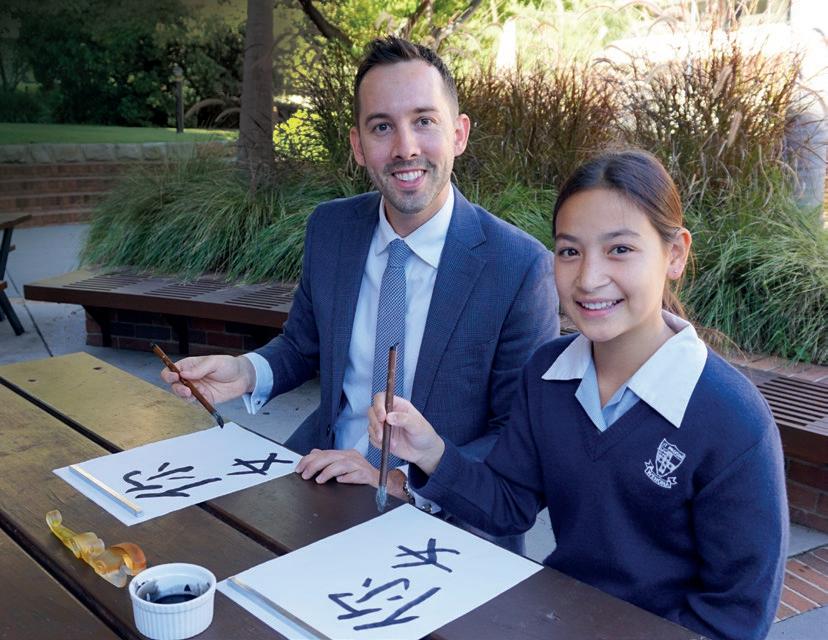
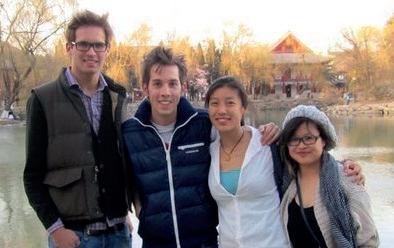
The value of seeing things differently
From an early age, I learnt that the most valuable perspective is the one you don’t yet have. My father is Danish, so we welcomed a constant stream of international visitors to our home. They brought an outsider’s perspective to our life, shining a light on the familiar and prompting us to see our routines, customs and stories through different eyes.

My family also hosted exchange students from countries like Japan, Korea, China, Denmark and Tonga, whose different languages, cultures and backgrounds expanded our worldview. Most of us don’t realise how culturally conditioned our behaviours and routines are because to us they are ‘normal’, but our exchange students added a deeper layer to the way we understood ourselves and our life in Australia.
In Year 10, I too became an exchange student, travelling to Tonga, where I had to negotiate language barriers, learning to greet people appropriately and observe and interpret their gestures. This experience expanded my insight and my ability to communicate
and relate to others away from my familiar support network. But most of all, it highlighted to me the value of seeing things differently.
A love of Asian languages
I studied Japanese at school from Years 4 to 7. I then elected to continue via distance education in Years 9 and 10, which was challenging. I think this was when I first developed an interest in Asian languages and culture. After school, I became a specialist English teacher at a high school in the north of Thailand. Initially, I didn’t intend to learn the language, but I fell in love with the people and the culture, so I started studying Thai every afternoon until I was able to read, write and speak the language proficiently. In 2019, I had an opportunity to revisit Thailand as part of a Wenona service learning tour. My host family didn’t speak English, so my Thai was really put to the test. I was delighted that I could recall enough of the language to write a thank you note before we left!
My abiding interest in Asian languages prompted me to study for a Combined Bachelor of Laws and Arts at The University of Sydney, majoring in Chinese Studies and Government and International Relations. In 2009, I received the Dean’s Award and was subsequently awarded a scholarship to study Chinese in Taiwan. This enabled me to develop my language skills to such an extent that in 2011, I was awarded a place to study at China’s most prestigious tertiary institution: Tsinghua University in Beijing. Taking classes in Mandarin on Chinese foreign policy alongside the best and brightest students in China really accelerated my language acquisition.
The case for language learning
My fluency in Mandarin has been invaluable during my career, both as a solicitor and as a teacher at Wenona. I also have an Advanced Diploma of Translation and have worked as a professional

translator (NAATI Level 3 Professional Translator Accreditation).
Working in Hong Kong for international law firm, King & Wood Mallesons, my ability to communicate with Chinese clients was a considerable asset. When I took up a subsequent role at a commercial law firm in Denmark (where I was able to connect with my Danish identity culturally and linguistically), I continued to write articles in Chinese for the firm’s Chinese language website.
Along with sharing my love of Asia and Mandarin with my students at Wenona, I have represented the School at expos in Australia and in China. Here, I visited schools in Beijing (including my alma mater, Tsinghua University), Guangzhou, Hangzhou and Shanghai, helping to foster interinstitutional relationships and develop Wenona’s global links. I have hosted Chinese government delegations and Chinese education officials at Wenona, and interpreted for presentations, tours, workshops and Q&A sessions. And my language skills have also helped to strengthen ties between the School and the Chinese-speaking community, both locally and overseas.
There is a Chinese proverb that says, “To learn a language is to have one more window from which to look at the world.” For me, the ability to speak more than one language has expanded my world, enabling me to connect with a diversity of people and cultures in new and exciting ways.
Intercultural understanding
More than ever, students are exposed to news media that often presents over-simplified or biased perspectives on world events such as climate change, racism and radicalisation.
Ready for the world
In 2018, I established a Model United Nations Assembly (MUNA), along with fellow Languages Teacher, Ms Vanessa Furlong Alexanderson. The aim of MUNA is to help students foster international mindedness by debating global challenges such as climate change, racism and radicalisation from the standpoint of a particular country, sometimes delivering their speeches in that country’s native language. The program has encouraged students to develop their cultural sensitivity and understanding and respectfully engage in tough conversations with people with different viewpoints and values to their own. As an outward-facing school, Wenona recognises that its students are part of the world’s first truly global generation. As such, it is important we equip them to successfully live, study and work across different cultures and languages in a globalising world. We also recognise the significant contribution that our international students - and our CALD staff and students - bring to the School. Not only do they deliver a fresh injection of culture, ideas and perspectives, but they also strengthen our international and cultural ties, and diversify our social mix. Everyone in our community - staff, students and their families - benefits from exposure to social and cultural diversity, which translates into
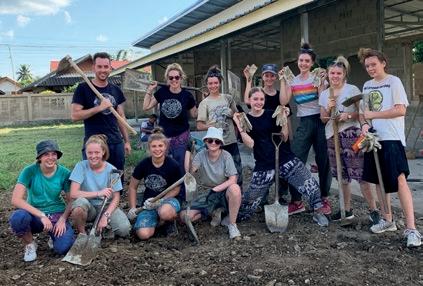
a greater capacity to flourish in a global economy. In 2019, I was appointed as the inaugural International Development Coordinator for Wenona. The objective of the role is to embed a coordinated, best practice approach to international education across the School; to develop and enhance Wenona’s reputation as a centre of global excellence for teaching, learning and innovation; and to forge innovative partnerships with education, government and industry that will enable international education at Wenona to diversify and grow.
International Education
In October 2019, I attended the Australian International Education Conference in Perth, along with 1,500 leading international education professionals across the secondary and tertiary education sector. We discussed best practice in international education, including issues such as the internationalisation of the curriculum, international student enrolments, international student wellbeing programs, overseas student exchanges, international partnerships and transnational education programs. One of the most interesting presentations was from the Victorian Department of Education and Training. I drew inspiration from learning how the department is integrating global learning and engagement across its schools, which I hope will help to inform Wenona’s approach moving forward.
100 hours
For high school students (Years 7-10), the Australian minimum requirement for study of Languages Other Than English (LOTE) is 100 hours
Wenona students do over
350+ hours
of LOTE
(Languages other than English) learning across Years 7-10 In Australia
22.2%
of households
speak a language other than English at home There has been an increase of
181% over the preceding four years
in the proportion of job advertisements seeking bilingual candidates
REFLECTION
Forging a strong partnership with the outside world, goes to the very core of Wenona.
The opposing global reactions to the COVID-19 pandemic illustrates that we are living in a world polarised by different political, cultural, religious, environmental and economic views. Now, more than ever, our students need the knowledge, skills and attitudes to appreciate and respect people from different communities and cultures. It is critical therefore, that we successfully prepare our students for life as active, informed and engaged citizens with a global outlook.
The Director of Global and International Studies at Wenona, Mr Antonio Boschiero is currently working to establish a sister-school program in different countries. The aim is to: • Broaden students’ perspectives • Develop students’ intercultural capabilities • Increase student understanding of themselves and their own culture • Enhance and promote student language learning • Contribute to a whole school program of internationalisation • Build teacher capacity While Wenona has a unique professional development program for its staff, which includes international Teaching Fellowships and Seeding Grants, a sister-school program will provide additional collaborative learning opportunities for our staff. It will enable them to benchmark their practice against other school systems, increase their awareness and understanding of different pedagogies and curriculum, and strengthen their intercultural understanding and sensitivity to different points of view.
As International Development Coordinator, I am also establishing a Global Learning, Engagement and Diversity Framework for the School to promote a strategic whole-school approach to international education. Under the Framework, a Global Steering Committee, comprised of a diversity of students and staff, will help to create a Global Action Plan to develop Wenona’s global networks and perspectives, with the flow-on effect of internationalising the ethos of the whole school learning community.

WEAVING A NEW WEB
Safeguarding our online world
BY ROBYN WAINE
PDHPE TEACHER AND ASSISTANT YEAR COORDINATOR
Maximising the opportunities for our children as they grow up in a connected world is critical, but we must also take steps to minimise the risks. Robyn Waine attended the eSafety Conference, with politicians, business leaders, academics and experts coming together to create a safer and more civil online world.
On 15 March 2019, a lone gunman killed 51 people and injured 50 others as they worshipped at the Al Noor Mosque and the Linwood Islamic Centre in Christchurch, New Zealand. For an agonising 16 minutes and 55 seconds, the gunman live-streamed the first attack on Facebook, with the aim of spreading hate and fear. The scale of this horrific video’s reach was staggering. In the first 24 hours, it had been viewed some 4,000 times before Facebook removed it. A further 1.5 million copies were subsequently taken down, but the video remains available on the web despite the measures taken to remove it.
Social media platforms give a powerful voice to the voiceless. Regardless of a person’s geographic location, educational background, gender, or socioeconomic status, all voices on social media platforms have value. But the same technology that allows people to galvanise democracy, education and equality can also be used to promote racism, misogyny and homophobia. No one should have the ability to broadcast mass murder. Nor should we, or our young people, be exposed to violent, incendiary or toxic content when we log on to our social media. It seems reasonable to expect that along with government regulation, the world’s most innovative companies should use their ingenuity to censor hate speech. And yet far too many people continue to inadvertently fall down the online rabbit hole of disinformation, manipulation and incitement. So, what measures can we take to change this?
eSafety Conference 2019
In September 2019, I had the privilege of attending the third trans-Tasman eSafety Conference at the Hilton Hotel in Sydney. Hosted by eSafety Commissioner, Julie Inman Grant and Martin Cocker, CEO of Netsafe New Zealand, the twoday conference brought together a smorgasbord of academics, policy makers, business leaders and thinkers, with the shared purpose of reimagining our online world and devising concrete steps towards positive change. There were video addresses from the Prime Minister, Scott Morrison and New Zealand’s Prime Minister, Jacinda Ardern. The discussion panels were thought-provoking and at times, harrowing. But ultimately, they offered a framework for enlightened public policy and evidence-based educational solutions to make our online - and our offline - world a better, safer and more civil place.
Beyond the Christchurch Call
Prime Minister Jacinda Ardern recorded a moving opening address for the Beyond the Christchurch Call panel. She highlighted the harms that can be caused by terrorist and violent extremist content online, a threat that continues to evolve. Along with French President Emmanuel Macron, Ardern has led the Christchurch Call, an action plan that commits government and tech companies to a range of
measures. This includes developing tools to prevent the upload of terrorist and violent extremist content; countering the roots of violent extremism; increasing transparency around the removal and detection of content; and reviewing how companies’ algorithms direct users to violent extremist content.
Highlighting the mounting number of attacks on immigrants and other minorities worldwide, panellists raised their concerns about the connection between inflammatory speech online and violent acts. They also discussed the role of the media and its potential to magnify discord by publishing terrorist manifestos or graphic details about victims. Above all, they emphasised the need for governments across the world to work together with civil society, harnessing the creativity and technical know-how of tech companies, to reconcile free expression with non-discrimination in order to make the world a safer place for all.
Online child exploitation
In an age when children learn how to use an iPad before they learn how to ride a bike, the exploitation of children on the internet is an ongoing challenge. It’s critical that technology companies work closely with child protection experts and the police to block and remove exploitative photos and videos and prevent online grooming. This panel focused on the work of Australia’s eSafety Commission in combatting child exploitation online. It has joined forces with child protection organisations internationally to build a comprehensive global database that identifies and removes child sexual abuse content from the internet. It is also piloting Project Arachnid, an automated web crawler and platform based at the Canadian Centre for Child Protection. Project Arachnid’s aim is to reduce the online availability of child sexual abuse material. One of its outcomes is the psychological relief offered to survivors of child sexual abuse material, who have had no control over the distribution and ongoing sharing of their recorded sexual abuse.
Image-based abuse
Our digitised lives have given rise to new concerns as technology alters the way we interact. In this always-on world, having an online presence often extends to our personal relationships too. This panel highlighted the difficulties of helping young people to navigate this tricky terrain through adolescence, particularly for the parents and teachers who aren’t as technically-literate as their children or students.
Our young people are connected. They share photos on Instagram. They send Snapchats to their friends instead of calling them. But they don’t always make wise decisions about what they’re posting; nor do they necessarily understand the legal and emotional consequences of what they’re sharing. And unfortunately, an impulsive moment to send a photo can ruin lives.
Sexting, according to the standard definition, is the sharing of sexualised or explicit images or texts through the internet using digital devices, emails or apps, regardless of consent. Image-based abuse occurs when intimate, nude or sexual images are distributed without the consent of those pictured. This includes real, altered, and drawn pictures and videos, and humiliating and degrading filming, such as schoolyard fights or hazing videos where there is no consent to being filmed. Image-based abuse can also include the threat of the image being shared.
The panellists acknowledged that while laws to protect children are a necessity, criminalising cruel or childish behaviour will not solve the problem we are trying to overcome. And we must also ensure that we do not compromise our young people’s right to self-expression and sexual agency. Telling them to abstain from sexting does not work. Instead, we must teach them about online risk, respectful relationships and positive, healthy online behaviour.
Cyberbullying
Large social media companies, including YouTube, TikTok and Snapchat, have a significant number of young users, so it’s imperative that they mitigate against the risk of online harm. This includes sexual abuse, pro-suicide content and cyberbullying. The panel noted that in the case of young people, almost all online abuse is peer to peer and has a nexus to social conflict within schools. Children who are victimised in the playground are often targets online too, so there’s a need to address the root problems of bullying in all its online and offline forms.
The panel also observed that as a society, we’re far more aware about the effects of sexual abuse and domestic violence, yet in the online world, our






